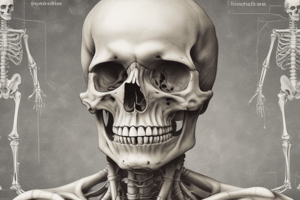Podcast
Questions and Answers
What is a key characteristic of congenital perineal groove (CPG)?
What is a key characteristic of congenital perineal groove (CPG)?
- Typically observed in males
- Presence of a dry sulcus without mucous membrane
- Manifestation as a moist sulcus involving the perianal region (correct)
- Usually requires immediate surgical intervention
How is congenital perineal groove (CPG) usually identified?
How is congenital perineal groove (CPG) usually identified?
- Through blood tests
- By MRI imaging
- By genetic testing
- Via visual inspection (correct)
When does congenital perineal groove (CPG) typically resolve spontaneously?
When does congenital perineal groove (CPG) typically resolve spontaneously?
- Only in male children
- In children under the age of two (correct)
- In children over the age of five
- After surgical intervention
Why must care be taken to protect the urethra during surgical procedures for CPG in male patients?
Why must care be taken to protect the urethra during surgical procedures for CPG in male patients?
Why are exact incidence figures of congenital perineal groove (CPG) difficult to calculate?
Why are exact incidence figures of congenital perineal groove (CPG) difficult to calculate?
What is the general approach regarding surgical intervention for congenital perineal groove (CPG)?
What is the general approach regarding surgical intervention for congenital perineal groove (CPG)?
What symptom was commonly experienced by the male patients with congenital perineal groove?
What symptom was commonly experienced by the male patients with congenital perineal groove?
What age range did the male patients fall into in the study by Dr. Kang et al.?
What age range did the male patients fall into in the study by Dr. Kang et al.?
What does the Anal Position Index (API) indicate in male patients with congenital perineal groove?
What does the Anal Position Index (API) indicate in male patients with congenital perineal groove?
What is a unique aspect of congenital perineal groove (CPG) observed more in male patients?
What is a unique aspect of congenital perineal groove (CPG) observed more in male patients?
Which condition is NOT listed as a potentially associated condition in male patients with congenital perineal groove?
Which condition is NOT listed as a potentially associated condition in male patients with congenital perineal groove?
Study Notes
Congenital and Perineal Infections
Overview of Congenital Perineal Groove (CPG)
Congenital perineal groove (CPG) is a rare condition characterized by the presence of a moist sulcus with mucous membrane, often involving the perianal region. It is generally observed in females and considered a regional variant of perineum anomalies. Exact incidence figures are difficult to calculate due to its rarity. However, it tends to manifest itself as a partial form, with the sulcus ranging from the perineum to the anus rather than scrotum-anus. This condition is typically identified by visual inspection and differentiated from other conditions such as anal fissures, dermatitis, trauma, or sexual abuse.
CPG is usually asymptomatic and may resolve spontaneously in children under the age of two years. Surgical intervention is typically reserved for those older than two years who experience bothersome symptoms or if the condition is associated with other perineal abnormalities requiring surgical correction. During surgical procedures, care must be taken to protect the urethra in male patients given the proximity of the sulcus to this structure.
Despite being relatively rare, congenital perineal grooves have been reported in both male and female patients. Studies suggest that males are less frequently affected, and when diagnosed, they more commonly present with the partial form of CPG. This condition may also be confused with other perianal conditions, necessitating careful assessment and diagnostic evaluation.
Characteristics and Treatment of CPG in Male Patients
The study by Dr. Kang et al. presents four male patients with congenital perineal groove, providing insights into their demographics, clinical presentation, and outcomes. These patients experienced various symptoms, including intermittent mucosal hemorrhage and mucous secretion with soiling. Their ages ranged between 4 years and 10 years. Additionally, these male patients had varying anal position indices (APIs), indicating the degree of anterior displacement of the anus. All patients underwent successful surgical treatments, and their subsequent follow-ups did not reveal any symptom recurrences within the observation period of 5 to 8 months.
This study highlights several unique aspects of CPG in male patients compared to female patients:
- Shortening of the perineum with an anterior anus: This feature is more pronounced in male patients, potentially reflecting differences in perineal development during fetal growth.
- Association with other perineal malformations: Males with CPG may also exhibit conditions such as hydrocele, imperforate anus, rectoperineal fistula, and a sacral split.
- Partial type occurrence: As mentioned earlier, most male patients with CPG present with the partial form of the condition.
Although some studies report favorable prognoses following surgical intervention, additional research is needed to validate these findings and improve understanding of this condition in male patients.
Studying That Suits You
Use AI to generate personalized quizzes and flashcards to suit your learning preferences.
Description
Explore the characteristics and treatment outcomes of congenital perineal groove (CPG) in male patients through a study by Dr. Kang et al. Learn about the demographics, clinical presentation, and surgical interventions for this rare condition. Understand the unique aspects of CPG in males, including shortening of the perineum, association with other perineal malformations, and the prevalence of the partial type occurrence.




